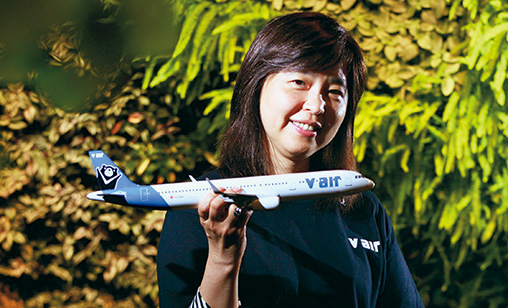Addendum
Terrible twos knock out Taiwan’s V Air
September 1st 2016
What a difference a month can make. When your correspondent spoke to V Air chief executive, Eleni Lung, in August, the mood was light, cheerful even. Read More » Lung and her team were preparing the winter season schedule. Fast forward three weeks, and the Taiwanese LCC, controlled by TransAsia Airways, announced it would shut down on October 1, two years after it was launched.
“TransAsia Airways passed a board resolution today (August 9), and officially announced service suspension of V Air, its 100%-owned low-cost airline, from October 1,” said TransAsia chairman, Vincent Lin. The TransAsia boss said folding V Air back into the parent company allowed a speedier recovery at the airline group.
 |
TransAsia reported a net loss of NT$439 million ($14 million) for the first quarter, easing from a net loss of NT$1.2 billion in the previous three months. However, sales dropped significantly from NT$10.6 billion in fourth-quarter 2015 to NT$3.2 billion in the first quarter of this year. The carrier had two fatal crashes in 2014 and 2015 that killed 91 people.
Following the disappointing performance, TransAsia said it would sell or lease its four in-service A330-300s. The airline mainly flies the wide body jets between Taiwan and Japan. Increased competition has forced it to downsize to the A320 and A321 on its Japan routes.
Taiwan’s third-largest airline company, following China Airlines (CAL) and EVA Air, will terminate services to Okinawa, Guiyang and Macau from October 30, leaving only Tokyo, Osaka, Sapporo, Siem Reap, Palau and twelve Mainland cities in its network.
Only months earlier Lin had said he wanted TransAsia to build a “hybrid” business model between a traditional carrier and a budget carrier, effectively signalling that V Air’s budget offering faced an uncertain future.
“LCCs are such a new industry in Taiwan. In other countries such as Japan, there is a lot of government support, and they have specific terminals for LCCs. In Korea, they have protected route permits, but in Taiwan it is so new that the government does not really protect the LCC companies,” Lung told Orient Aviation. In other words, Taiwanese LCCs use the same terminal at Taipei Taoyuan International Airport as their full-service counterparts, at the same cost. Budget carriers operating in Taiwan have grown from zero in 2004 to 20 this year.
Lung said: “there are two runways at Taoyuan but they are always under construction. There are hours when we cannot use the runways”. Lung added Taiwanese LCCs were barred from using Taipei’s downtown Songshan Airport.
“We don’t feel we have much support from the government. For instance, for new route applications we have to compete with legacy airlines. They have a lot of experience, and hence get a lot of scoring points. For us, as a new company, we’re at a disadvantage.”
In terms of the dual branding strategy between V Air and TransAsia, Lung said her carrier focused on secondary destinations not served by the parent, including Nagoya and Chiang Mai, while TransAsia capitalized on the traditional trunk routes, cross-strait and domestic flights.
V Air has two A321s and two A320s. Lung said in August the plan was to add two Airbus planes to V Air’s fleet this year, but already cautioned then that “the entire economy in Taiwan isn’t going too well”, so the carrier was reviewing its expansion strategy.
Launched in December 2014, V Air last year reportedly recorded losses of NT$450 million ($14.3 million). Its bottom line has continued to deteriorate since, with aggregate losses in the first half of this year exceeding NT$900 million, nearly half its founding paid-in capital of NT$2 billion.
Asked about financial performance, Lung said V Air was “of course” not profitable yet. “But everything is on track as budgeted, so hopefully in the coming few years we’ll break even. We’re aiming at next year,” she said before she, and her carrier, were shown the door at V Air.
Passengers booked to Osaka and Naha after September 30 will be transferred to TransAsia Airways flights, while those travelling to Fukuoka and Chiang Mai will be rebooked once TransAsia secures the relevant route permits. Passengers bound for Bangkok, Busan and Nagoya will be fully refunded. Flights to Manila are already cancelled, while services to Haneda and Ibaraki will be suspended from September 20.
V Air was not alone in its uphill battle with mounting competition and only marginal profits. Taiwan media has suggested CAL is considering the fate of its Tigerair Taiwan subsidiary: either to recapitalize it or fold into its Mandarin Airlines unit.
Potentially a precursor for what is to come, Tigerair Taiwan has reduced frequencies from Taipei to Fukuoka, Hakodate and Nagoya, as well as from Kaohsiung to Macau and Narita. Tigerair Taiwan has admitted its load factors have dropped on some routes, like Nagoya, because it has significantly increased its flights to Japan.
New CAL chairman, Ho Nuan-hsuan, confirmed the parent company has established a task force to study the future of Tigerair Taiwan. CAL holds an 80% stake in Tigerair Taiwan, its Mandarin Airlines unit 10%, with the remainder owned by Singapore’s Tiger Airways Holdings.